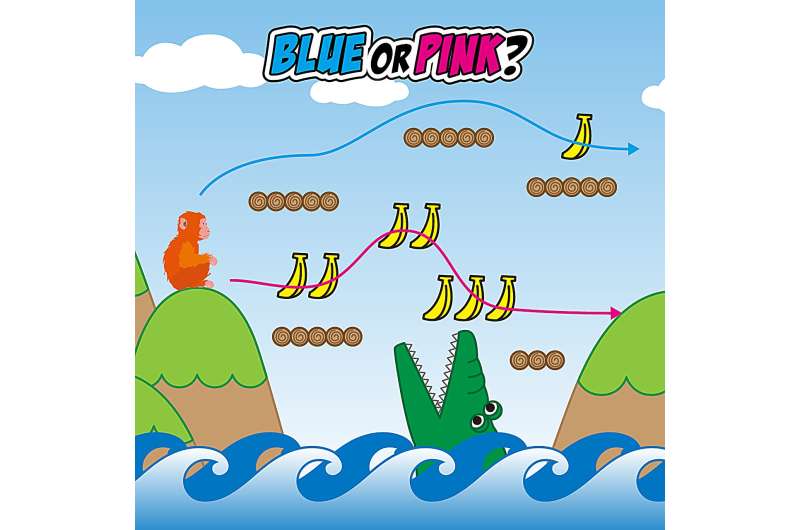
Life consists of infinite potentialities—showing in the actual world as a number of selections, that then require decision-making in an effort to decide the most effective plan of action. Nevertheless, with each selection there additionally exists a certain quantity of uncertainty or “danger.” Subsequently, behind each resolution, lies an intricate analysis course of that balances the dangers and rewards related to taking such actions.
This will, in excessive circumstances, present itself as a pathological behavioral state of excessive risk-high return (HH) and low risk-low return (LL) resolution processing that has been related to playing issues.
Though these larger cognitive processes happen seamlessly throughout the cerebral cortex of our brains—dozens to a whole lot of occasions every day—the precise underlying neural circuits have remained elusive as a result of technical difficulties of particularly focusing on and manipulating these neural circuits.
A brand new research revealed Science, from a staff of researchers led by Dr. Tadashi Isa on the Institute for the Superior Research of Human Biology (WPI-ASHBi) and Graduate College of Drugs/Kyoto College, have recognized and selectively manipulated utilizing optogenetics—a way that may modulate the exercise of particular neurons with gentle—the distinct neural circuits answerable for balancing danger vs. reward-return decision-making in primates.
They present the behavioral modifications ensuing from stimulating these circuits accumulate over time and have long-term penalties—unbiased of any stimulus—offering insights into potential mechanisms underlying pathological risk-taking behaviors akin to playing issues.
Numerous experimental paradigms have been developed to guage decision-making habits, with the Iowa Playing Activity being arguably essentially the most well-known. Nevertheless, such neuropsychological duties are sometimes restricted by their design, as they can’t sufficiently uncouple higher-order cognitive processes.
To find out the “pure” selection bias between HH and LL choices, Isa and colleagues first designed their very own resolution paradigm to uncouple risk-dependent selection habits from different higher-order cognitive processes.
Utilizing eye motion to point their selection, macaque monkeys have been educated to carry out a cue/goal selection process with water as their reward, consisting of 5 completely different HH-LL selections throughout 5 completely different units of equal “anticipated worth” (quantity of reward awarded multiplied by chance), making a complete of 25 potential choices. According to different primate research that checked out risk-behavior, the authors discovered that primates had an inherent bias for HH over LL selections.
Within the early twentieth century, the cerebral cortex was mapped into 52 areas, generally known as Brodmann areas, primarily based on their distinct mobile morphology and group. The deeper, or ventral, elements of Brodmann space 6 (space 6V), have been lengthy thought to solely operate as a motor space in people and primates. However extra lately, areas overlapping space 6V have additionally been related to decision-making processes, although direct proof supporting such a operate has been missing.
By pharmacologically inactivating a number of candidate frontal mind areas, utilizing the selective GABAA receptor agonist muscimol, the authors discovered that the ventral a part of space 6V (space 6VV) to be answerable for the HH selection habits. Apparently, regardless of the orbitofrontal cortex (OFC) and the dorsal anterior cingulate cortex (aACC) being thought-about to play central roles in reward-based decision-making in monkeys, inactivating these areas had little impact on choice for HH selection.
“Certainly, we have been actually stunned that neither the OFC nor the aACC have been vital for risk-dependent decision-making,” feedback Dr. Ryo Sasaki, the primary writer of the research.
The ventral tegmental space (VTA) of the mind is crucial for reward-associated processes, which is integral to risk-related decision-making. A subpopulation of dopaminergic neurons residing within the VTA are related to the prefrontal cortex, together with space 6V, also referred to as the mesofrontal (or the mesocortical) pathway.
To dissect the particular position of the mesofrontal pathway in risk-dependent decision-making, Isa and collaborators used a sublime optogenetic technique, whereby an array consisting of 29 LED lights coupled to electrocorticogram (ECoG) electrodes was engineered (dimensions: 19 mm x 12 mm) and implanted into space 6V of primate brains expressing photoactivatable proteins in VTA neurons.
Through the slender time window of decision-making, the authors exactly manipulated the neural exercise of outlined VTA terminals in space 6V by turning ON particular LEDs of their array, whereas concurrently recording the exercise inside space 6V, that additionally included extra superficial, or dorsal areas (space 6VD; roughly 2–3 mm above space 6VV).
The authors uncovered two subcircuits throughout the mesofrontal pathway with distinct roles in risk-dependent decision-making. They discovered HH-preference was depending on the VTA-6VV pathway, whereas LL choice was depending on the VTA-6VD pathway.
“The spatiotemporal decision of our LED/ECoG array was important in distinguishing the VTA-6VV and VTA-6VD pathways and deciphering their distinct purposeful roles in risk-dependent decision-making,” claims Sasaki.
These findings have been additional validated by computational decoding, which recapitulated the selection choice habits induced by photostimulation in primates in silico.
Apparently, upon repetitive stimulation of both the VTA-6VV or the VTA-6VD pathways, Isa and co-authors noticed cumulative results that persevered over time, resulting in long-term modifications in choice for HH and LL selection in primates, respectively—unbiased of any photostimulation. Isa feedback, “…such long-term modifications in selection habits have been reasonably surprising … however this will now additionally supply a mechanistic rationalization for the way playing issues come up.”
Precisely how these distinct circuits contribute to balancing our day-to-day decision-making stays unclear, however the authors imagine different mind areas are prone to additionally contribute to this course of.
“Contemplating the similarities (in construction and performance) between human and non-human primate brains, our findings might have potential therapeutic implications, and even purposes sooner or later, for the remedy of pathological types of risk-taking akin to playing issues,” he says.
Extra data:
Ryo Sasaki et al, Balancing risk-return choices by manipulating the mesofrontal circuits in primates, Science (2024). DOI: 10.1126/science.adj6645. www.science.org/doi/10.1126/science.adj6645
Supplied by
Institute for the Superior Research of Human Biology (ASHBI)
Quotation:
Researchers establish and manipulate neural circuits for danger/reward decision-making in primates (2024, January 4)
retrieved 4 January 2024
from
This doc is topic to copyright. Other than any truthful dealing for the aim of personal research or analysis, no
half could also be reproduced with out the written permission. The content material is supplied for data functions solely.







